Monte magic: Stirling Moss in the 1961 Monaco Grand Prix
This was the win Sir Stirling Moss picked as his best, an against-the-odds showing that stunned the more powerful Ferraris. Mark Hughes picks up the tale of the 1961 Monaco GP
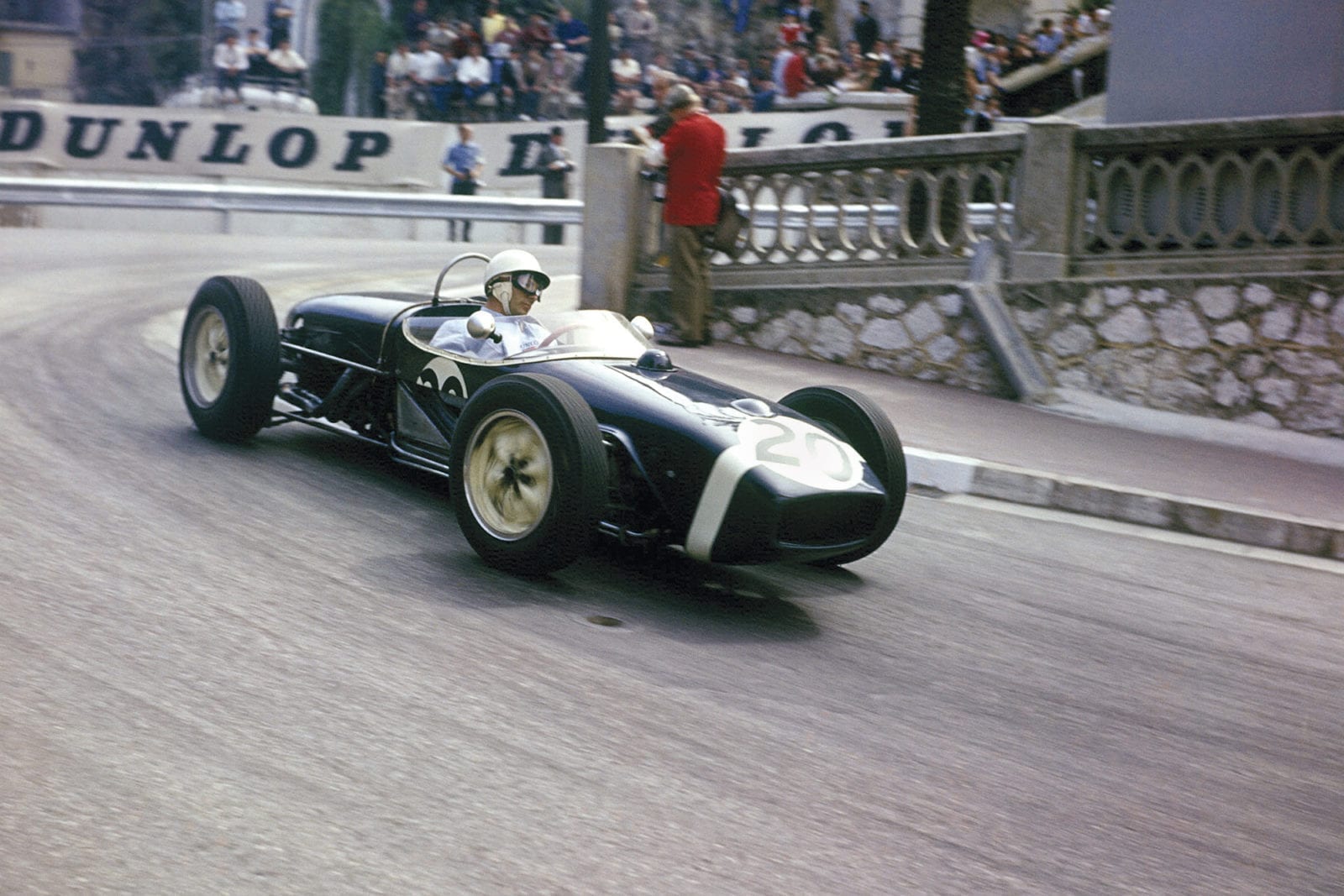
GP Library
Monaco 1961 has been hailed as perhaps the most brilliant of all of Stirling Moss’s 16 grand prix victories, as he triumphed over the crack Scuderia Ferrari squad and its phalanx of powerful sharknose 156s in his year-old, privately- owned Lotus 18.
The result was impressive, but it laid bare the genius of Moss in full flight, back against the wall and responding with almost three hours of flat-out, on-the-limit virtuosity to keep himself just out of reach of pursuers, armed with around 25 per cent more horsepower than he enjoyed from the four- cylinder Climax behind his shoulders. He couldn’t afford to let a red car get within striking distance, as it would surely use its superior acceleration out of one of the slow corners to place its driver in Moss’s slipstream. Establishing and maintaining that gap required qualifying levels of focus and concentration for lap after hot, arduous lap, staying flat-out between the unyielding walls and barriers for almost all of the 100 laps – that and a few beautifully judged pressure moves on backmarkers that minimised his time loss.
In the duel between Moss and the most tenacious of his Ferrari-mounted pursuers, Richie Ginther, they each lapped 2.8sec under Moss’s pole position time. This was only 0.1sec slower than the previous year’s fastest lap – set by a 2.5-litre car, whereas this was the first race of the new 1.5-litre formula.
How did this miracle drive happen? What were the factors?
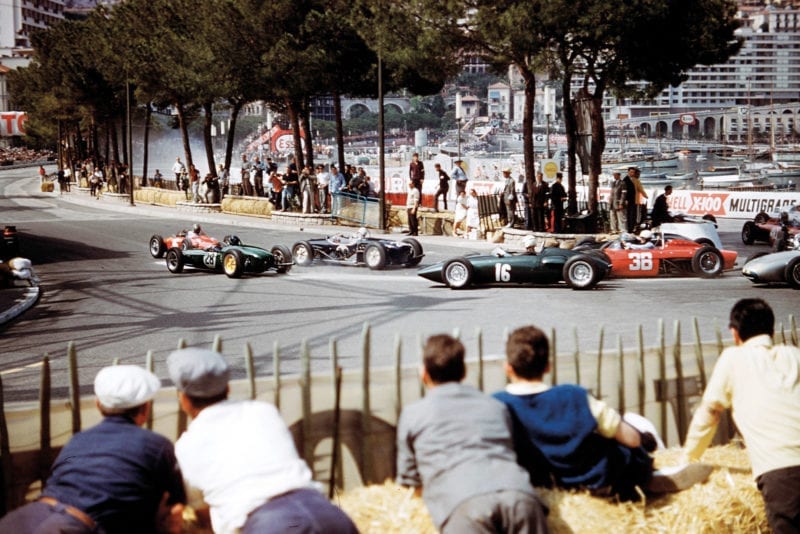
Ferrari’s Richie Ginther leads, with Jim Clark and Moss in pursuit at the start of the ’61 Monaco GP
The brilliance of Moss
This factor remains unquestioned. Here was the recognised world’s greatest driver at the peak of his powers, 31 years old and with seven full seasons of Formula 1 experience behind him. Even his peers regarded him with awe. “Moss was the best I ever raced against,” said Ginther in the 1970s, post- retirement. “That son of a gun. If you did well against him, you knew you’d done something real special…” On that day Ginther, in what was only his second race for the Scuderia, did indeed produce a special performance, just by hanging onto Moss.
After three days of practice, Moss put Rob Walker’s year-old Lotus 18, modified to the new 1.5-litre regulations, on pole position and 0.3sec clear of Ginther in the fastest of the three works Ferraris. Ginther’s sharknose 156 featured the new 120-degree V6 engine rather than the older-spec 65-degree V6s in the otherwise similar cars of senior drivers Phil Hill and Wolfgang von Trips. Ginther, as Ferrari’s new recruit, had been assigned the new unit – which produced around 190bhp, 10 more than the 65-deg engine and 40 more than the four- cylinder Climax Moss had – as it was still considered an experimental development with unproven reliability.
Joining Moss and Ginther on the three- car front row was the new works Lotus 21 of Jim Clark, in just his second season of F1 after a few exploratory outings the previous year. An update of the 18, but visibly sleeker and lower-slung, the 21 was mechanically quite similar and powered by the same four- cylinder Climax. Clark – who’d arrived in F1 with barely any previous single-seater experience – caused something of a sensation by topping the times on the first day of qualifying, but he then crashed the car heavily at Ste Devote, restricting him from any further running as it was straightened and rebuilt.
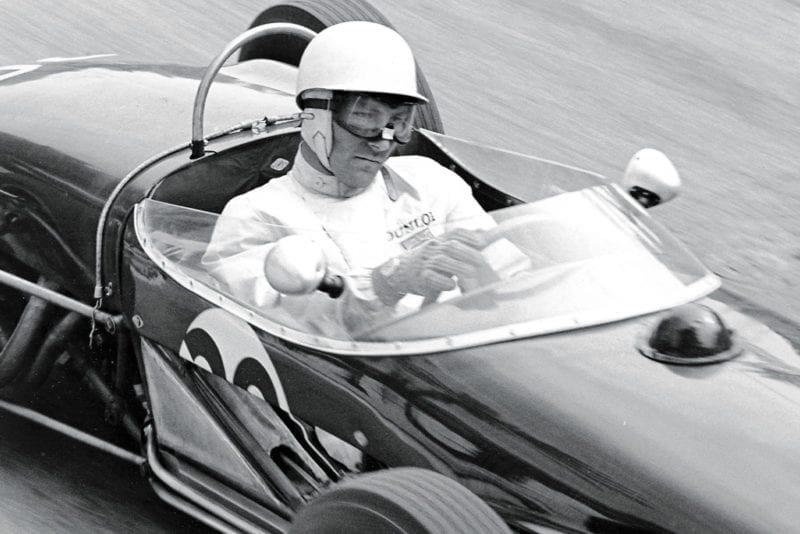
Moss at the wheel of his Rob Walker Racing-run Lotus 18, having removed side panels to help cooling
What Moss – and probably Clark, too – was doing so effectively around these Monaco streets was exploiting a chassis advantage brilliantly. It was there, but it was difficult to access.
“The Lotus was definitely faster than the Cooper,” explained Moss, “but was much more demanding. It was easy to drive the Cooper quickly. But to get the Lotus to go quicker than the Cooper was hard work, and you always had the feeling it might bite you.” During practice, Moss had even tried the Cooper that Rob Walker had as a spare car, just to confirm to himself that the Lotus was the better tool for the job.
Power vs grip
Even back in 1961, Monaco was probably the least power-sensitive track on the calendar. Nonetheless, the Ferrari’s advantage of 40bhp would still have been worth a lot, especially as that represented a power boost of around 25 per cent. Considering today’s power figures, 40bhp between engines of around 1000bhp would be worth around 0.3sec of Monaco lap time. With engines of less than 200bhp, that 40bhp should have bought perhaps double that. But instead of being on pole by 0.6sec, the fastest Ferrari was 0.2sec adrift of the pole – so around 0.8sec slower than the engine advantage should have given.
Some of that was undoubtedly Moss. But some was derived from the more advanced chassis and suspension of the Lotus. The cars behaved quite differently, as explained in the technical panel (right). The Ferrari, with its rudimentary Cooper-like multi-tube chassis and non-reversed wishbone suspension, had nowhere near the Lotus’ resistance to roll and forced its rear tyres to run a very different slip angle in corners compared to the more modern car, on which Colin Chapman had expanded a lot of effort on maximising tyre grip.
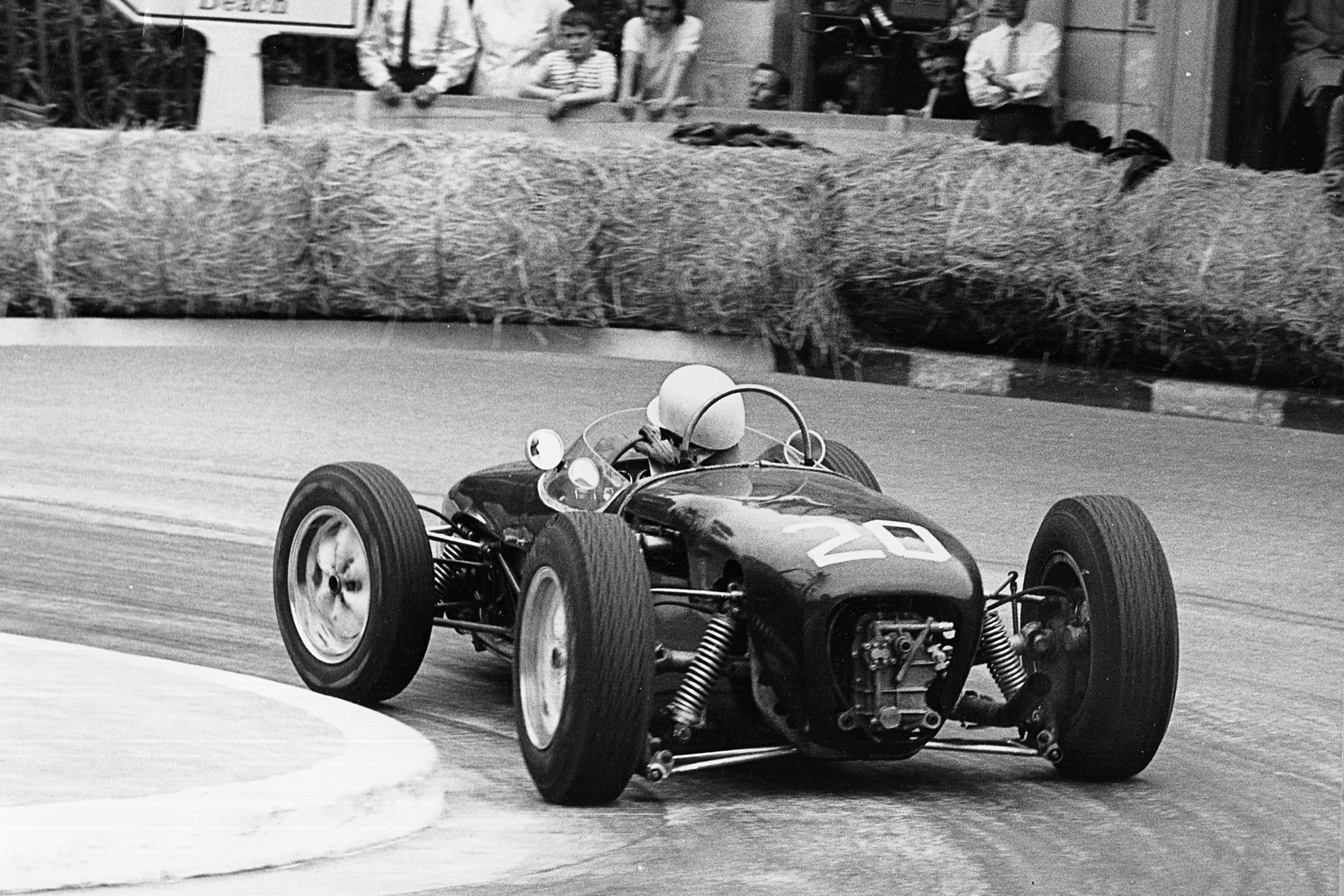
It’s possible to see this playing out in race footage. Where the left of Massenet transitions into the right of Casino, Moss needed less road to exit and could take a wider approach into Casino. By contrast, Ginther – with more initial understeer going in and more oversteer as the fronts then load up – would be pulled out of Massenet wider, as a consequence of the Ferrari needing more time and track width to stabilise into each corner. He’d then be on a shallower approach line to Casino.
“The key skill was the entry phase, and Moss was the master”
Down into the station hairpin, Moss was earlier and neater into the turn, a brief squeal of rubber audible as he loads that outer front – and the tyre accepts him pivoting the car around it, Stirling then instantly neutralising any further slide by coming off the brakes and getting early on the power. Both the chasing Ginther and Phil Hill are forced to take a more geometric line, doing more of the initial turn with steering, rather than weight transfer. With the Cooper-style suspension of the Ferraris, there’s no way they could have been driven in the efficient Lotus way. Down at the chicane – much faster and more flowing than today, and with a formidable-looking wall defining its apex – Moss is audibly on the power before the car even appears in shot. The Ferrari drivers step on the power maybe half-a-second later into the sequence, their cars looser and more unruly, preventing their drivers from skimming that wall quite so closely.
Driving the Lotus in this way, getting it to rotate early by braking it into the turn but not allowing that rotation to build momentum into a slide, took a very fine balance and feel. Cars of the previous 2.5- litre era had more power than grip, and the key to being fast had been all about the drift, holding the car on the throttle against rear tyres running a high slip angle. But now, with small engines and Lotus’ sophisticated chassis, they had more grip than power.
The key deciding skill had moved to the crucial initial entry phase. Moss was the master of both.
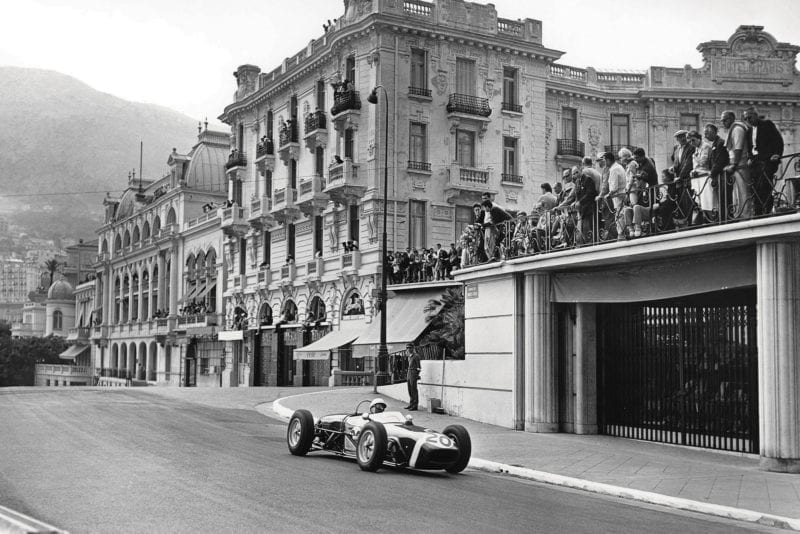
Finding an edge: Moss on his way into Casino Square, where he could maximise the better grip of the Lotus compared to the Ferraris
Archives Automobile Club de Monaco
Last minute drama
It was a hot day in Monaco. Moss had the Lotus’ aluminium side panels removed to give the cockpit some air circulation and had taken the precaution of having a drinks bottle fitted – a useful innovation.
But as the cars sat preparing to go to the grid, Moss was standing to the side of the Lotus and noticed with horror that one of the chassis tubes was broken. The spaceframe car took its structural strength from the geometric arrangement of these tubes– and it would have become undriveable had this not been spotted. Mechanic Alf Francis draped some wet cloths around the adjacent fuel tank and used his welding torch right there in the road.
Early laps

Pole man Moss (left) couldn’t prevent Ginther’s Ferrari from slipping ahead at the start, and then Clark (right)
Louis Chiron dropped the flag at the start – which back then was on a straight joining Tabac to the Nogués hairpin (without the swimming pool section) – and Ginther lit up the Ferrari beautifully, using that power advantage to accelerate into the lead, Moss surrendering a further place at the hairpin to Clark. The latter’s engine was not running cleanly, and he was making his way to the pits, with Moss now second but somewhat taken back at the pace being set by Ginther, who by the end of the third lap was 5sec clear.
Jo Bonnier, in his new Porsche 908 (still with the four-cylinder engine, awaiting the flat-eight), had broken free of the snarling pack behind and glued himself to Moss’s gearbox. By his own later admission, it took Moss a few laps to get in his stride on this day, but he was rather shocked into it by Ginther’s explosive early pace.
Focusing himself, he set about closing that gap back down, pulling Bonnier along in his wake. By the eighth lap, he had the gap down to 1.5sec. By the 14th, they’d caught the Ferrari and Moss was able to take the lead, getting a better exit out of Ste Devote, slipstreaming Ginther up the hill and diving to his inside on the approach to Massenet. Later in the lap Bonnier would also squeak by the Ferrari, but by now Moss was properly into his rhythm and pulled steadily away. By lap 25 – quarter-distance – he was leading by 10sec.
“I wouldn’t normally have gone for the lead so soon,” he said afterwards, “but it seemed the right thing to do.”
Track gripping up
Ginther had been passed by team-mate Phil Hill but the two Ferraris had then caught and passed Bonnier. Moss had used their dicing to pull away, keeping up an extraordinary pace for lap after relentless lap. Convinced that the Ferraris were just playing with him and that they had the pace to close when the moment came, Moss was intent on building the gap while he could. But it wasn’t long before the two Ferraris matched his pace, then began gradually eroding the 10sec gap.
All three were lapping at a pace that was unfeasibly close to the low-fuel runs of qualifying. That suggested the track was gripping up significantly, even with the thin tyres of the time. This was good news for Moss in that the greater the track grip, the bigger advantage a grippier car can take. On the other hand, the greater fuel consumption of Ferrari’s higher-revving V6 would have meant its weight disadvantage would have been at its greatest at the start and would now be reducing towards parity. Whatever, the combined Ferrari assault on Moss’s lead was well and truly underway between the quarter and half distance.
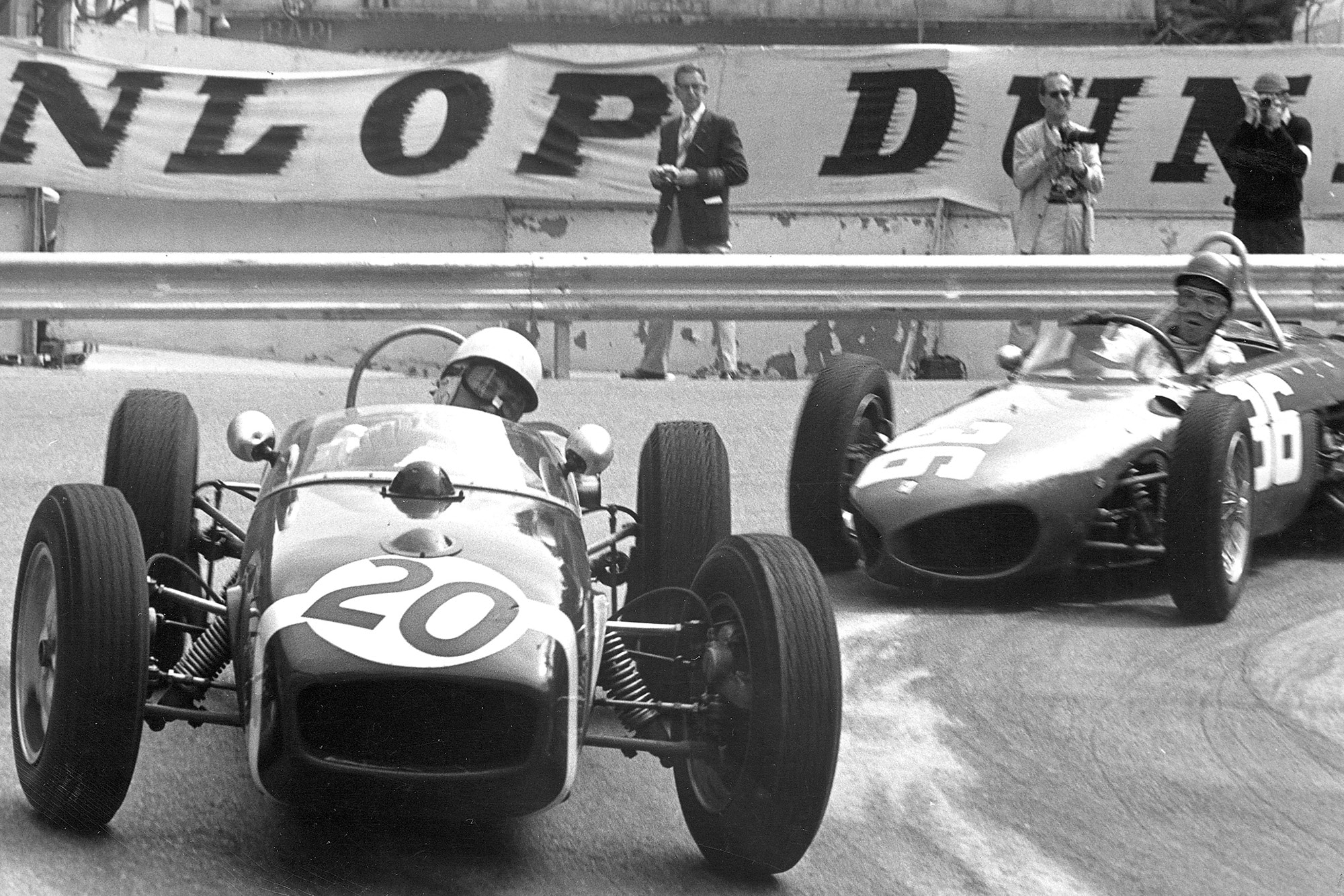
By lap 50, the gap was down to 7sec – and all three were lapping in the 1min 38secs, well under Moss’s pole position time of 1min 39.1sec.
Moss was informed of the closing gap by his pitboard, but he could go no faster; he was now in a trance-like, on-the-limit rhythm as he sought to keep those Ferraris off his back.
A mesmerising game played out as the dark blue car now began to lap the backmarkers, the following scarlet formation now adding a third member as von Trips took over fourth position following the retirement of Bonnier with an airlock in the Porsche’s new-fangled fuel injection system.
Ferrari tactics cost time
Between the 50th and 60th lap the Ferraris reduced the gap from 7sec to 3sec and Moss could now see them in his mirrors.
“Moss’s extraordinary drive was putting pressure on Ferrari”
But this mighty effort seemed to have taken a physical toll on Hill, as it was increasingly apparent that Ginther was being held up by his team-mate. On several occasions he got his car partly alongside into the gasworks hairpin (Nogués). There was a discussion on the Ferrari pitwall. Team manager Eugenio Dragoni ordered a ‘Ginth- Hill’ pitboard be prepared. It was hung out to them on the 73rd lap. Hill stayed ahead for yet another lap, but finally pulled aside going up the hill out of Ste Devote to start lap 75.
Once free, Ginther pulled away, and the question was inevitably asked post-race about how much time had been lost by Ferrari delaying the switch-around decision.
Moss may have felt under pressure, but his extraordinary drive was in turn applying swathes of pressure to the Ferrari team.
Use of lapped cars
Moss was now only keeping Ginther off his back by some extraordinary use of the backmarkers, Motor Sport’s Denis Jenkinson reporting that it was as if Moss possessed some sort of extra sense in anticipating where they would be. Every time the pair was in clear air, Ginther would close the gap. Moss would then ease it back out again as he negotiated lapped cars. It was, commented Jenkinson, “rather like a fighter plane being chased by a superior enemy and being saved by dodging into the clouds”.
On the 84th lap Ginther prepared to do the lap of his life at 1min 36.3sec, fully 2.8sec under the pole position time and just 0.1sec slower than the 2.5-litre fastest lap from the 1960 race. On the very next lap, Moss equalled Ginther’s benchmark.
After a breather, Ginther renewed his attack from the 91st lap, but still Moss remained in his mesmerising rhythm, in a place of heightened senses even for him.
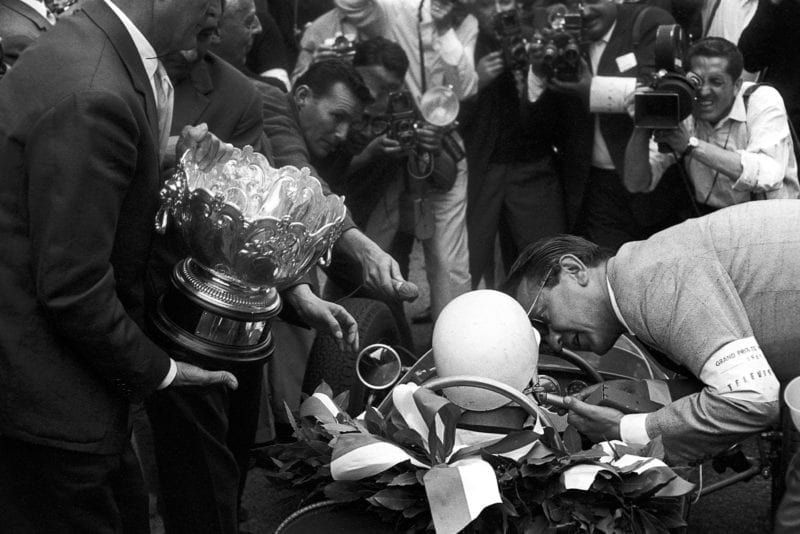
The rewards of victory, moments after completing his greatest race
After 100 laps, clerk of the course Chiron dropped the checker at the approaching Moss. Ginther passed the line 3.6sec later, with Hill and von Trips filling out the red behind the dark blue. The Ferraris were in for a truly dominant season, but Moss had pulled off something extraordinary in the year’s opening salvo.
“Without a doubt, that was my best race,” said Moss in retirement. “I had to drive flat-out for all but about 11 of 100 laps. And I mean flat-out. For the first few laps I was happy to pace myself, but when the others started to speed up I felt that I had to keep with the pack. Going into the last few laps I thought they’d been playing with me, and I was thinking, ‘Here we go, this is where they put their foot down and take me’. From what I heard, they were given signals by the Ferrari pits to ‘give all’, but I managed to stay in front.”

